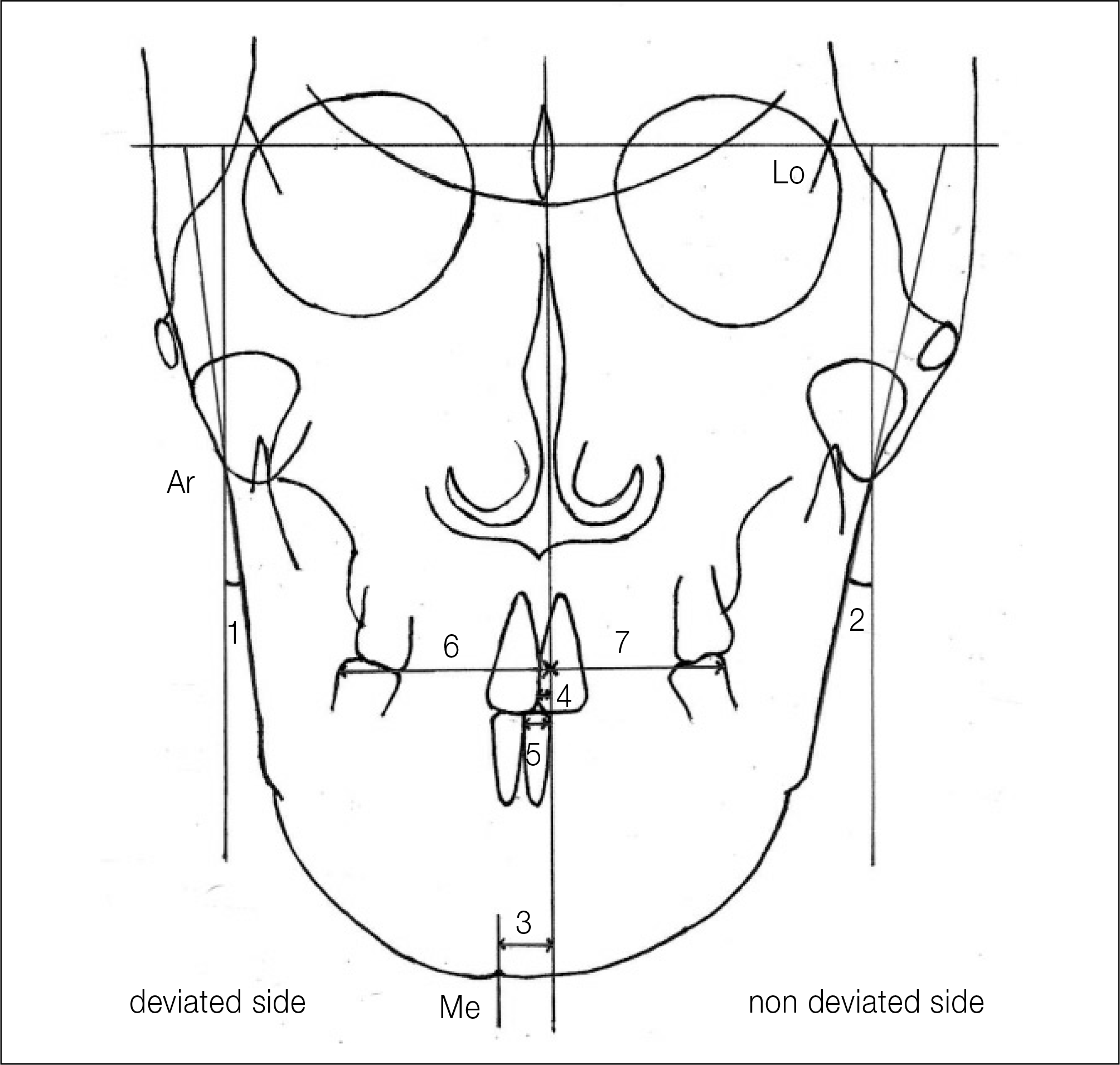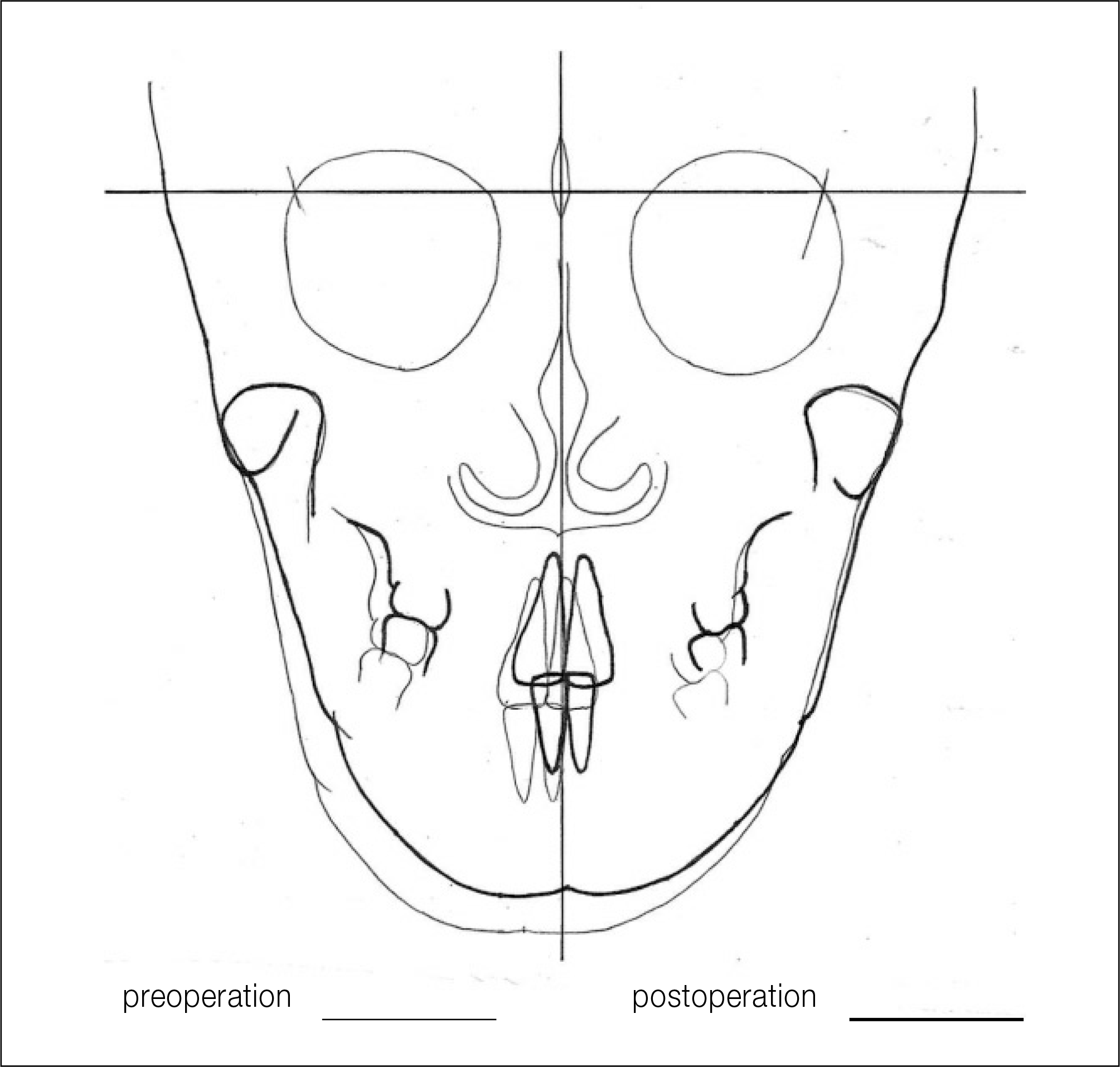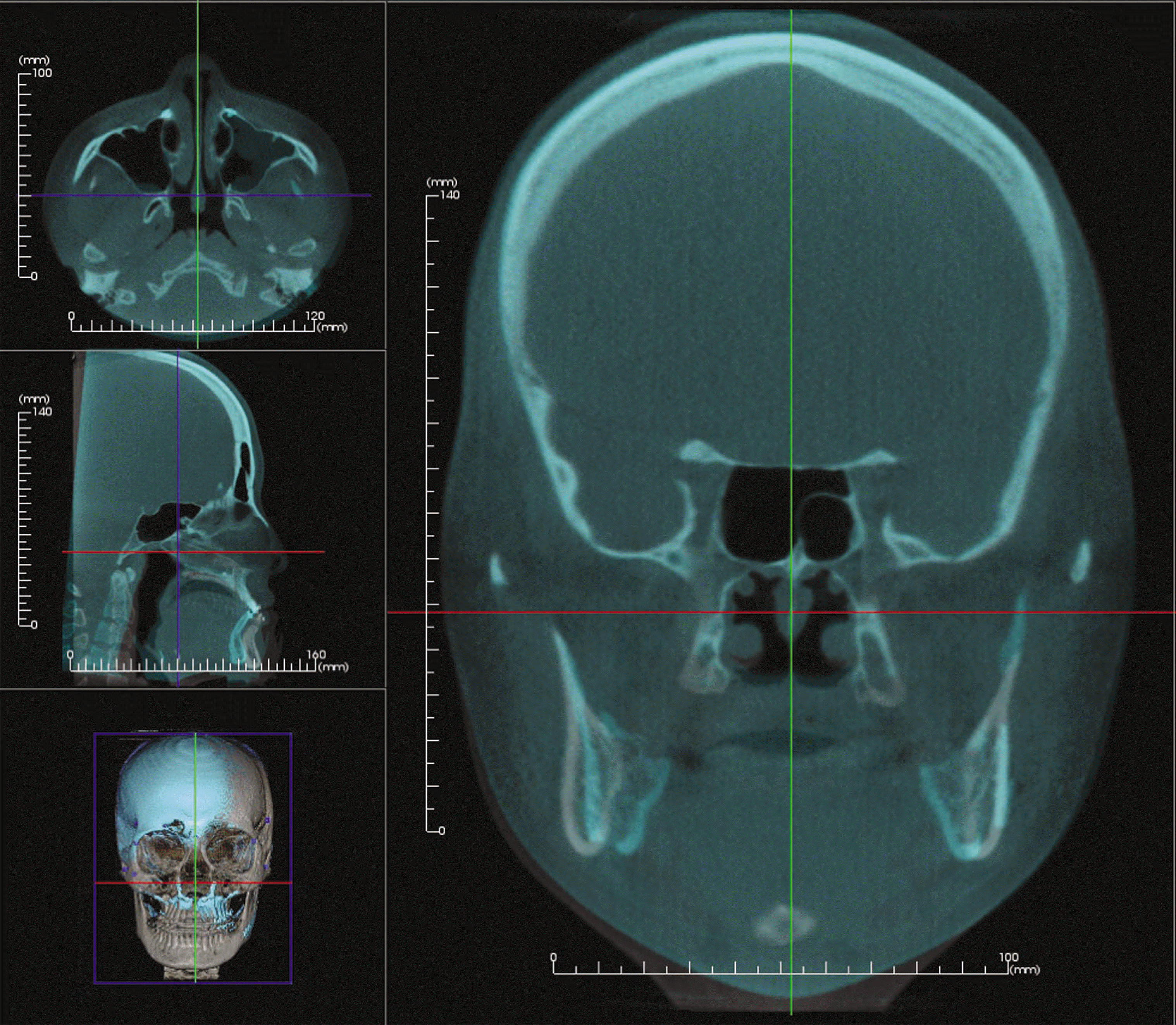Abstract
Introduction
To compare the change in frontal ramal inclination (FRI) in laterognathism after orthognathic surgery.
Materials and Methods
Twenty four patients (10 men, 14 women; mean age, 22.8±5.2 years) with minimal facial canting (≤2 mm) and apparent menton deviation (5.9±2.4 mm) who had been operated on to correct facial asymmetry and skeletal CIII malocclusion, were selected. On a preoperative posteroanterior (PA) cephalogram, the FRI of the deviated side and non deviated side, L1 deviation amounts and menton deviation amounts were measured. The FRI differences between both sides were compared, and the correlations between the measured deviated elements and the FRI differences were analyzed. On a postoperative PA cephalogram, the shifting amount of L1, shifting amount of L7 and FRI of both sides were measured, and the correlations between the shifting elements and the change in FRI were analyzed.
Results
On the preoperative PA cephalogram, the FRI of the non deviated side was significantly greater than those of the deviated side. The differences in FRI, with a menton deviation amount showed a significant correlation. On the postoperative PA cephalogram, the FRI differences between the deviated and non deviated side were decreased significantly and mandibular transverse movement toward central position was noted. The mean shifting amounts of L7 were associated with the amount of change in the deviated side of FRI.
References
1. Komori M, Kawamura S, Ishihara S. Averageness or symmetry: which is more important for facial attractiveness? Acta Psychol (Amst). 2009; 131:136–42.

2. Jones BC, DeBruine LM, Little AC. The role of symmetry in attraction to average faces. Percept Psychophys. 2007; 69:1273–7.

3. Padwa BL, Kaiser MO, Kaban LB. Occlusal cant in the frontal plane as a reflection of facial asymmetry. J Oral Maxillofac Surg. 1997; 55:811–6. discussion 817.

4. Peck S, Peck L, Kataja M. Skeletal asymmetry in esthetically pleasing faces. Angle Orthod. 1991; 61:43–8.
5. Phillips C, Bennett ME, Broder HL. Dentofacial disharmony: psychological status of patients seeking treatment consultation. Angle Orthod. 1998; 68:547–56.
6. Nitzan DW, Katsnelson A, Bermanis I, Brin I, Casap N. The clinical characteristics of condylar hyperplasia: experience with 61 patients. J Oral Maxillofac Surg. 2008; 66:312–8.

7. Park SH, Yu HS, Kim KD, Lee KJ, Baik HS. A proposal for a new analysis of craniofacial morphology by 3-dimensional computed tomography. Am J Orthod Dentofacial Orthop. 2006; 129:600. .e23–34.

8. Hayashi K, Muguruma T, Hamaya M, Mizoguchi I. Morphologic characteristics of the dentition and palate in cases of skeletal asymmetry. Angle Orthod. 2004; 74:26–30.
9. Nojima K, Yokose T, Ishii T, Kobayashi M, Nishii Y. Tooth axis and skeletal structures in mandibular molar vertical sections in jaw deformity with facial asymmetry using MPR images. Bull Tokyo Dent Coll. 2007; 48:171–6.

10. Langberg BJ, Arai K, Miner RM. Transverse skeletal and dental asymmetry in adults with unilateral lingual posterior crossbite. Am J Orthod Dentofacial Orthop. 2005; 127:6–15. discussion 15–6.

11. Ishizaki K, Suzuki K, Mito T, Tanaka EM, Sato S. Morphologic, functional, and occlusal characterization of mandibular lateral displacement malocclusion. Am J Orthod Dentofacial Orthop. 2010; 137:454. .e1–9; discussion 454–5.

12. Hwang HS. Maxillofacial 3-D image analysis for the diagnosis of facial asymmetry. J Korean Dent Assoc. 2004; 42:76–83.
13. Eun CS, Hwang HS. Posteroanterior cephalometric study of frontal ramal inclination in chin-deviated individuals. Korean J Orthod. 2006; 36:380–7.
14. Hwang HS, Hwang CH, Lee KH, Kang BC. Maxillofacial 3-dimensional image analysis for the diagnosis of facial asymmetry. Am J Orthod Dentofacial Orthop. 2006; 130:779–85.

15. Sekiya T, Nakamura Y, Oikawa T, Ishii H, Hirashita A, Seto K. Elimination of transverse dental compensation is critical for treatment of patients with severe facial asymmetry. Am J Orthod Dentofacial Orthop. 2010; 137:552–62.

16. Hashimoto T, Fukunaga T, Kuroda S, Sakai Y, Yamashiro T, Takano-Yamamoto T. Mandibular deviation and canted maxillary occlusal plane treated with miniscrews and intraoral vertical ramus osteotomy: functional and morphologic changes. Am J Orthod Dentofacial Orthop. 2009; 136:868–77.

17. Pinto AS, Buschang PH, Throckmorton GS, Chen P. Morphological and positional asymmetries of young children with functional unilateral posterior crossbite. Am J Orthod Dentofacial Orthop. 2001; 120:513–20.

18. Goto TK, Nishida S, Yahagi M, Langenbach GE, Nakamura Y, Tokumori K, et al. Size and orientation of masticatory muscles in patients with mandibular laterognathism. J Dent Res. 2006; 85:552–6.

19. Yang HJ, Lee WJ, Yi WJ, Hwang SJ. Interferences between mandibular proximal and distal segments in orthognathic surgery for patients with asymmetric mandibular prognathism depending on different osteotomy techniques. Oral Surg Oral Med Oral Pathol Oral Radiol Endod. 2010; 110:18–24.

20. Buranastidporn B, Hisano M, Soma K. Temporomandibular joint internal derangement in mandibular asymmetry. What is the relationship? Eur J Orthod. 2006; 28:83–8.
21. Uysal T, Sisman Y, Kurt G, Ramoglu SI. Condylar and ramal vertical asymmetry in unilateral and bilateral posterior crossbite patients and a normal occlusion sample. Am J Orthod Dentofacial Orthop. 2009; 136:37–43.

22. Akahane Y, Deguchi T, Hunt NP. Morphology of the temporomandibular joint in skeletal class iii symmetrical and asymmetrical cases: a study by cephalometric laminography. J Orthod. 2001; 28:119–28.

23. Tallents RH, Guay JA, Katzberg RW, Murphy W, Proskin H. Angular and linear comparisons with unilateral mandibular asymmetry. J Craniomandib Disord. 1991; 5:135–42.
Fig. 1.
Cephalometric landmarks and measurements used in this study: FRI of deviated side, FRI of non deviated side, amount of menton deviation, amount of U1 deviation, amount of L1 deviation, linear L7 of deviated side, linear L7 of nondeviated side.(FRI: frontal ramal inclination)

Fig. 2.
Diagram of FRI change after parallel shifting of mandibular body.(FRI: frontal ramal inclination)

Table 1.
Preoperative deviated amounts in laterognathism
Table 2.
Postoperative shifting amounts of deviated elements in laterognathism
Table 3.
Comparison of FRI and difference between non deviated side and deviated side in laterognathism (�)
| Non deviated side | Deviated side | Difference | Significance | |
|---|---|---|---|---|
| Mean±SD | Mean±SD | Mean±SD | Significance | |
| Preoperative FRI� | 11.5±3.3� | 5.6±3.5� | 5.9±2.3� | * |
Table 4.
Pearson correlation between FRI difference and U1 midline deviation, L1 midline deviation, menton deviation amount in laterognathism (preoperation)
| U1 midline deviation (mm) | L1 midline deviation (mm) | Menton deviation (mm) | |
|---|---|---|---|
| Difference of FRI� between deviated and non deviated side | 0.058 | 0.256 | 0.679* |
Table 5.
Comparison of FRI after operation (postoperative FRI�- preoperative FRI�)
| Preoperative FRI� Mean±SD | Postoperative FRI� Mean±SD | Difference� Mean±SD | Significance | |
|---|---|---|---|---|
| Non deviated side | 11.5±3.3� | 9.9±3.2� | −1.6±1.5� | * |
| Deviated side | 5.6±3.5� | 10.4±3.4� | 4.8±1.4� | * |
Table 6.
Comparison of FRI and FRI change amount between non deviated side and deviated side after operation (�)
| Non deviated side Mean±SD | Deviated side Mean±SD | Difference Mean±SD | Significance | |
|---|---|---|---|---|
| Postoperative FRI� | 9.9±3.2 | 10.4±3.4 | −0.4±2.2 | NS |
| Change amount of FRI� after operation | −1.6±1.7 | 4.8±1.4 | 3.1±2 | * |
Table 7.
Comparison of difference between L1 shifting amount and mean L7 shifting amount after operation
| L1 shifting amount Mean±SD | L7 shifting amount Mean±SD | Difference Mean±SD | Significance | |
|---|---|---|---|---|
| Difference (preoperative distance-postoperative distance) | 4.9±1.6 | 3.8±0.9 | 1.18±1.36 | * |
Table 8.
Pearson correlation between FRI changes and L1 shifting amount, L7 shifting amount (deviated site, non deviated site, mean) after operation
| L1 shifting amount (mm) | L7 shifting amount (deviated side, mm) | L7 shifting amount (non deviated side, mm) | Mean L7 shifting amount (mm) | |
|---|---|---|---|---|
| FRI� change of deviated site after operation | 0.414* | 0.704** | 0.723** | |
| FRI� change of non deviated site after operation | −0.056 | −0.229 | −0.120 |




 PDF
PDF ePub
ePub Citation
Citation Print
Print



 XML Download
XML Download